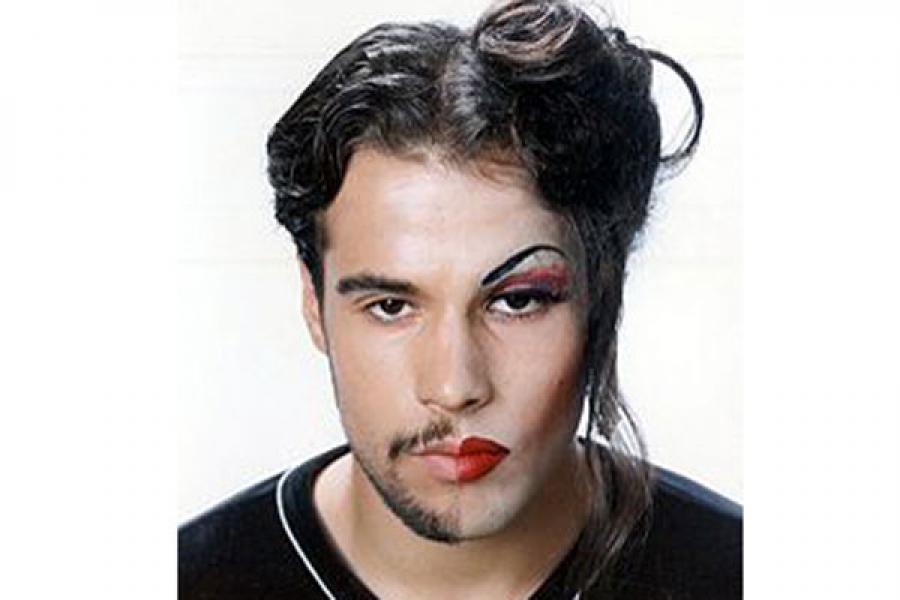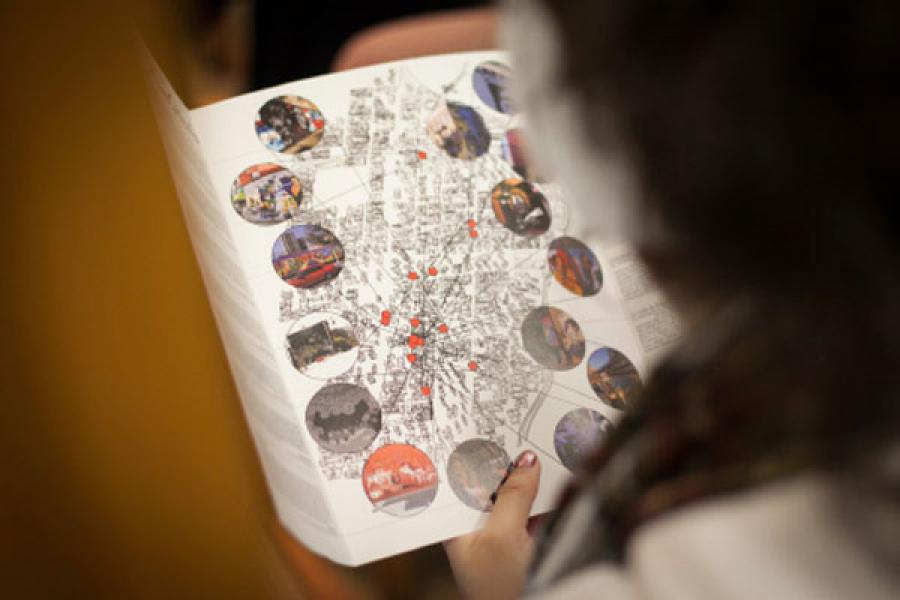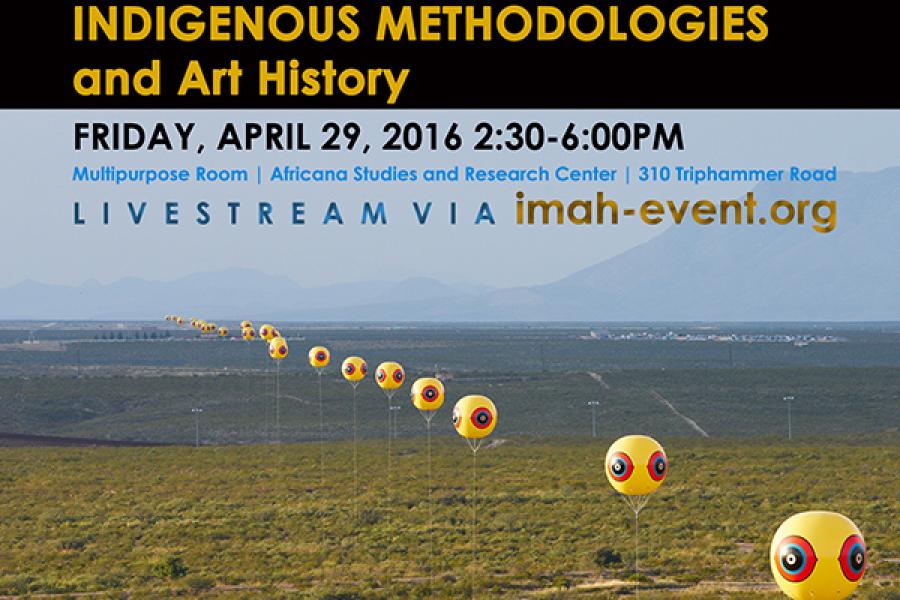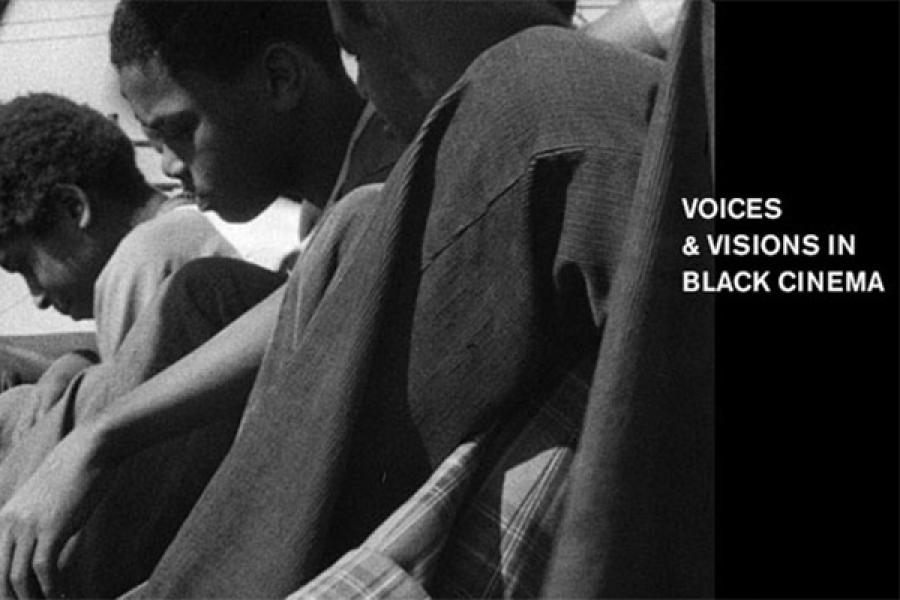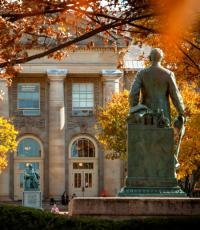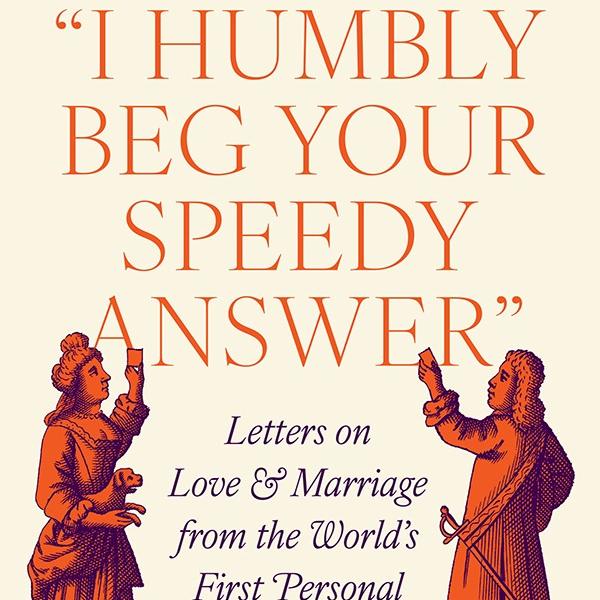Perhaps the most fundamental question we humans ask ourselves is, “who am I?” This quest for self-identification has spawned countless books, movies, and artworks; at Cornell, explorations of identity occur in classrooms, through scholarship and at myriad events.
In the last 25 years there’s been a real shift in student focus toward the issue, says Debra Castillo, professor of comparative literature and Latina/o studies: “There’s always been interest in social issues and the way we can bring our sensitivities to it, but as time has gone on there has been more attention to issues of identity.”
Today, even basic assumptions about identity are being called into question. C. Riley Snorton, assistant professor of Africana studies and feminist, gender, and sexuality studies, says that although people are commonly referred to as “having” identity, he finds it much more illuminating to talk about people “doing” identity.
This approach to identity arose from performance studies, explains Snorton, which shows that “the way that you exist in the world is based on people confirming you for you who you are. Rather than uncovering some sort of essential being, performance studies shows that identity gets crystallized through the encounters individuals have and how those encounters, or performances, are received and what is mirrored back.”
Professor of English Satya Mohanty describes identity similarly, as a social relationship, not an inner essence. “My identity (as a person of color, for instance) is not about my skin color or my inner feelings about who I am; the concept ‘person-of-color’ refers to the society in which I live,” he says. “So I’m not a person of color in, say, Jamaica because the term ‘person of color’ doesn’t refer—except very minimally—to actual skin color. My point is that it is not a descriptive term but rather an analytical term. It refers to my situation and the situation of people who are in the relevant sense like me in a particular society, with its own power structure.”
But Mohanty argues that identity is not just a social construct, at least not an arbitrary construct. When it refers accurately to a given power structure, it is “real” as well: identities have real epistemic and political consequences for how people experience the world. As he writes in “Identity Politics” (The Blackwell Encyclopedia of Cultural Theory, 2010), “Social identities can be mired in distorted ideologies, but they can also be the lenses through which we learn to view our world accurately. Our identities are not just imposed on us by society. Often we create positive and meaningful identities that enable us to better understand and negotiate the social world. They enable us to engage with the social world and in the process discover how it really works. They also make it possible for us to change the world and ourselves in valuable ways.”
Because of this complexity in explorations of identity, studies of the topic at Cornell tend to be interdisciplinary and comparative in focus. Says Shelley Wong, associate professor of English and Asian American studies, “you really can’t understand ‘this’ in isolation from ‘that’; Blackness has a certain meaning because yellowness or Asianness has a certain meaning, or whiteness or brownness or maleness and femaleness have certain meanings. It’s a hard idea sometimes for people to grasp. Our job as educators is to create a sufficiently comfortable environment so people don’t feel threatened, but that allows me to push students to think about things from a different angle.”
The Universal Human
The history of identity, says Snorton, is the story of its proliferation, and often that works very well for people who are looking for new language in which to express their lives. But it has another side to it as well, because such identities are proliferating in relation to the category of the “universal” human.
“I would suggest that all these categories of race and identity exist in order to leave a space open for thinking about what’s called the mythical being – the unmarked, naturalized person who can stand in for the universal human,” says Snorton. “That universal human has a set of identity categories, but those categories are not seen as ‘different.’ The fact that we have categories that are often markers of difference is I think very much due to the structural positioning of the universal vs. everyone else.”
This universal, says Snorton, is an ethnocentric masculine position. “When we think about gender, especially when we think about women and trans people, or racial designations, including Asian, indigenous, black are operating as the constellation around the unmarked in the center.”
Gender as an ambiguous phenomenon is demonstrated by a young Swedish actor.
In his new book project, “Black on Both Sides, Race and the Remaking of Trans History,” Snorton looks at flash points in history when the universal human has been managed and maintained, examining the kinds of categories of “difference” that are mobilized at these transition points to keep that figure of the universal intact.
In a talk given at Cornell in the Fall, “Worldview and Villainy in Native American Narratives,” Carol Warrior, a postdoctoral associate who will be an assistant professor of English next year, discussed how identity emerges from a variety of intersectional categories, including (but not limited to) race, economic status, nationality, sex, gender, language, religion, culture, age, health, hygiene, education, and occupation.
“Such categories are normalized in the West,” Warrior explains. “When an individual or a sub-culture violates categories through movement beyond or between boundaries, they are subject to vilification. Ideologically, the majority population embraces conformity to hierarchical arrangements of being and behavior. Conformity is considered a valid, definitive, and rigid rubric that measures the value of an individual or a group. People who violate the so-called integrity of the normed categories are met with discursive, psychological, and/or physical violence. The ‘violator’ is perceived as abject, monstrous, or otherwise fearsome, and sometimes even inhuman or expendable.”
Gender: A (Formerly) Bipartite System
Gender identity has become a non-rigid category in the contemporary moment; Snorton notes that some people talk about there being as many genders as there are beings in the world. He calls this “a real confrontation with the bipartite system.”
Assistant Professor of Philosophy Kate Manne’s research focuses on oppressive gender relations; her current book project is titled Down Girl: The Logic of Misogyny.
“A common idea in public discourse is that misogyny occurs because women are seen as less than fully human. I think that’s usually false,” says Manne. “Misogyny more often occurs because of women’s subordinate social position and men’s dominant social role.”
“Because misogyny involves an enforcement of women’s social position and their subordinate status in particular, there are lots of different mechanisms by means of which women are put in their place again when they have ‘ideas beyond their station:’ sexual objectification is just one of the many ways that someone’s humanity can be recognized and then the threatening aspects of their autonomous, minded nature defused,” she explains.
Manne analyzes some forms of racism, such as those which underlie police brutality against black Americans, similarly. “Dehumanization increasingly seems to me to be merely a symptom of the problem,” she wrote in a New York Times op-ed. “The problem being precisely that black people are being seen as people — and they are seen as being threatening, and taken down, because of it.” As racial minorities and women have gained social advancement and mobility, she explains that white men have had a relative loss in status. “Add to that the fact that they may find themselves surpassed by those they tacitly expected to be in social positions beneath them, and we have a recipe for resentment and the desire to regain dominance.”
Self-Awareness Through Education
Russell Rickford, assistant professor of history, emphasizes the need to think critically about race and identity in order to see how society conditions us to think certain ways. “It’s not a foregone conclusion that people will be motivated to think critically about this society and the possibilities for social change,” he says. “In a society that’s increasingly globalized and homogenized, where the range of ideas is narrow and there’s a proliferation of information but much of it narrow, human beings won’t engage in deep thought about ourselves and our society absent the kinds of courses of study that occur in the humanities.”
Rickford’s research focuses on the black radical tradition and black political culture after World War II. His new book, “We Are an African People: Independent Education, Black Power, and the Radical Imagination,” is an intellectual history of Pan Africanist schools from the 1960s to the present. In the book, Rickford shows how important cultural and political rebirth and renaissance was to Black power, and how those ideas inspired a wide range of grassroots organizing and quest for black institutions.
Ananda Cohen Suarez, assistant professor of history of art, recalls the classes that made a powerful difference in her university studies as those that taught her about herself and her family history, and allowed her to create deep connections between the contemporary condition of humanity and the historical past. “When I teach, often times I’ll get an email from a student at the end of the semester saying ‘I never knew about this before, it taught me so much about my heritage I never knew anything about.’ I see it in some ways as paying it forward, helping students understand the past and in turn to understand themselves.”
Students in an interdisciplinary class taught by Ananda Cohen Suarez, history of art, and Ella Maria Diaz, English and Latina/o studies, studied murals in New York City's El Barrio, learning about neighborhood aspects such as culture, history and preservation. Credit: University Photography
Says Noelani Gabriel ’16, “When I came to Cornell as a freshman I didn’t really have the language to describe many of the things I was frustrated about. My studies have allowed me to cultivate a more informed understanding of the causes I care so deeply about: education, the criminal justice system, mass incarceration – I’m able to understand them not just from an anecdotal or observational level, but from an institutional level with a critical approach and a critical eye.”
Ethnic Studies at Cornell
Cornell has long been a leader in ethnic-related identity studies, with programs in Africana studies, Asian American studies; feminist, gender and sexuality studies; lesbian, gay, bisexual, & transgender studies; Latina/o studies; Jewish studies; and American Indian and indigenous studies.
“Ethnic studies offers spaces where students feel comfortable; whether they’re part of the affinity group or not they have permission to talk about questions of race and identity,” says Derek Chang, director of the Asian American Studies Program and associate professor of history.
Chang is working on an ethnographic study of Asians in the Jim Crow south. “We think of Jim Crow as a system of segregation that focuses on the social, economic, and political lives of Blacks, but there were also Asians affected,” he says. “I’m interested in learning what we understand about Jim Crow in general by looking at the condition of Asians in the South.”
In ethnic studies, there is a conscious recognition that race is deployed and constructed relationally, says Chang. The programs at Cornell are thus constructed with a comparative emphasis. As an example, Chang notes that students in Asian American studies are required to take at least one course in Feminist, Gender and Sexuality Studies, Africana, or the American Indian and Indigenous Studies Program, so they can study the systems of race and power experienced in relation to others.
Indigenous studies, too, demands a cross-disciplinary approach, says Jolene Rickard, director of the American Indian and Indigenous Studies Program and professor of history of art, an approach she also takes in her curation and her own art. “When I’m teaching visual culture I’m also teaching about the physical and biological space of the Haudenosaunee biome. The broader space of indigenous studies covers politics, climate change, and environmental concerns, because place is hardwired into the philosophy, culture and art of indigenous peoples. There’s a lot to learn,” she says. She hosted a conference on “Indigenous Methodologies and Art History” at Cornell in May.
“The positive transformation of identities has been the basis of some of the most exciting developments in our times: Black liberation struggles, the LGBT movements, third-world decolonization, and so forth,” says Mohanty. “None of these movements grew automatically out of what people look like or even what they feel; they were based on the building of connections among people, on marking similarities and differences in their daily experiences and social interests.”
Campus Dialogue
Ethnic studies programs at Cornell have been instrumental in facilitating campus dialogue about recent national events centered around race in the United States, such as forums on events in Ferguson held at the Africana Studies and Research Center. Director Gerard Aching says that these events are “another example of how the work of faculty in the humanities, social sciences and beyond can help us think more deeply — with sophistication and nuance — about our society’s most pressing problems and, in so doing, move us in the direction of positive solutions.”
Oneka LaBennett, associate professor of Africana studies, points out that the current social justice movement is much more intersectional than previous civil rights conversations. “Black men and women have lost their lives, but there are also ways in which lesbian, gay, bi-sexual and trans people have been affected by this: the level of trans murders in this country has just skyrocketed to the point where activists see it as an epidemic. These are critical life and death issues and this is an important moment here where people are thinking intersectionally about what’s going on.”
“Students who take classes in programs like Africana and in the humanities more broadly are better equipped to express what it is that the groups who are the subjects of racialized inequalities are experiencing today, are able to give language in a way that’s very, very powerful,” adds LaBennett.
One of the authors LaBennett uses in her course, Being and Becoming Black: From Du Bois to Obama, is Ta-Nehisi Coates; she describes his work as “a humanist approach to complex social issues.” Members of the wider Cornell community used Coates’ recent book “Between the World and Me” to explore issues of race in America during six simultaneous small-group discussions of Coates’ book that took place across campus on April 28 as part of the New Century for the Humanities.
Participant in the small group discussion on Ta-Nehisi Coates' book "Between the World and Me" in Klarman Hall, April 28. Credit: University Photography
Another event examining issues related to identity during the New Century for the Humanities was a concert reading of Paula Vogel’s play “Indecent.” And in April, Teatrotaller collaborated with the student theatre group Melodramatics to offer an updated “West Side Story,” in which all the Latina/o roles were played by Latina/o students.
Teatrotaller (Spanish for theater-workshop) was founded it in 1993 to preserve and promote Spanish, Latin American and Latino cultures through theater at Cornell. The Hispanic Theater Production course taught by Castillo, in which students develop a dramatic text for full-scale production, serves as the core of Teatrotaller, which includes volunteer participants from Cornell, Ithaca College and the wider community.
Exploring Identity Through Art
Rickard situates herself in the subfield of art and social justice, where artists, she says, “are turning over our perceptions of reality to see more clearly structures that maintain oppression, structures of dominance that impact populations.” Last spring, she taught a University Course on Indigenous Ingenuities as Living Networks with Kurt Jordan, associate professor of anthropology, that explored Haudenosaunee knowledge and its application, with clan mothers and chiefs as speakers to help students learn about Cornell's local indigenous culture through Haudenosaunee understanding of themselves as a unique people.
Rickard served as a curator for two of the inaugural, opening exhibits at the Smithsonian National Museum of the American Indian in 2004: Our Lives, which featured a ‘wall of gold’ as an intervention on colonization, and Our Peoples, which had a contemporary focus and explored identity and history through personal narratives.
Samantha Sheppard, assistant professor of cinema and media studies in the Department of Performing and Media Arts, offered an examination of Black cinema in a series this past year at Cornell Cinema, “Voices and Visions in Black Cinema.” She’s working on a project titled “Muscle Memory: Black Embodiment in Sports Films” and an edited collection, “From Madea to Media Mogul: Theorizing Tyler Perry.” When she guides her students in dissecting films, she encourages them to consider the social forces that created them and what the audience experiences socially and historically.
“I want them to situate each text within a context, not because the films are reflections of reality but because they’re engaged in a social landscape,” she said. “My interest is in thinking about where black bodies are on screen en masse and how those black bodies can signify various histories.”
Wong has been working on a book about race, time, and narrative in Asian American and African American literature. Time, she says, “is something socially constructed, something continually made and remade in culturally specific ways.”
Wong is interested in how the meanings that have been assigned to the passing of time are put to political and aesthetic use. For example, she explains, with evolution, the significance of the passing of time has to do with ideas of progressive stages of development. Evolutionary anthropology had assigned each culture a particular spot on the “temporal slope” of evolutionary progress. “This understanding of time, far from being ideologically neutral, could serve political ends,” she says. “Arguments to exclude certain categories of immigrants were often couched in the language of evolutionary progress, denying entry to those considered ‘outsiders of evolution.’”
Identity in a Global Lens
LaBennett is working on an interdisciplinary, trans-national project about how black women artists in different global cities are engaged in an African diasporic conversation about black femininity. The project, called “Global Black Feminisms: Writing Art, Reading Hip Hop and Hearing Fiction,” examines what it means to be a black woman today and how these women use art to construct some form of shared experience.
LaBennett’s course, Being and Becoming Black: From DuBois to Obama, is, she says, “about black identity formation throughout the diaspora. It’s about the disparate cultural, national, historical and intellectual contexts in which Black identities are constructed, but it’s also about shared experience. What are the shared experiences that black people all over the globe have? And those shared experiences run the gamut from slavery to issues of mass incarceration and social inequality. In teaching that course I draw on my training as a social scientist but I also work through the humanities, because that enables students to have a more complete picture and helps them articulate their own experiences and understand experiences that might be different from their own.”
Cohen Suarez is exploring an early 20th century movement in Latin America known as Indigenismo (“indigenism”), dedicated to the valorization of the figure of the Indian in national consciousness. “This was a moment of national identity formation,” explains Cohen Suarez, “when they were taking stock of the colonial past and the pre-Columbian past and trying to create a cohesive narrative of a nation, reconstructing national identities in the post-colonial era around indigenous people.”
She is working on the project while on a Woodrow Wilson Foundation Career Enhancement Fellowship, awarded to junior faculty who have demonstrated commitment to eradicating racial disparities in core fields in the arts and sciences, and promoting cross-racial understanding in their university communities.
This feature is part of the New Century for the Humanities "Big Ideas" project to explore broad contemporary themes in the humanities. The New Century for the Humanities is a series of events and projects initiated to celebrate the opening of Klarman Hall, the first building dedicated to the humanities on Cornell's central campus in more than 100 years.

